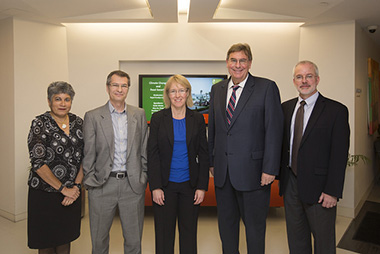Speaking at a recent policy seminar on climate change and food security, Heather McGray, Director of Vulnerability & Adaptation at the World Resources Institute (WRI), framed the challenge of climate change as twofold. “One of the hallmarks of climate change is growth in uncertainty about the weather—we just have trouble knowing what it’s going to do,” she said. At the same time, she said, we also know that weather patterns are becoming increasingly volatile. Taken together, these two characteristics of climate change—uncertainty and volatility—pose significant challenges to local and national policy makers.
Improved data and modeling capabilities are helping reduce some of this uncertainty, particularly at the global and regional levels. At the seminar, IFPRI researchers presented results of modeling analysis that can help policy makers respond.
IFPRI senior research fellow Keith Wiebe presented some of his team’s key findings, based on work using the International Model for Policy Analysis of Agricultural Commodities and Trade (IMPACT) Model. Although the IMPACT model largely focuses on agricultural commodities, Wiebe revealed that it draws data from other models on climate, water, and economics in order to paint a more complete picture on how these variables interact with one another.
So, what does the IMPACT model teach us about food security under future climate change scenarios?
Wiebe noted that looking at crop models and climate in isolation will give us an incomplete, and therefore inaccurate, picture of likely food security outcomes.
The climate change picture is in fact more nuanced. Wiebe pointed out that the effects of climate change may actually increase yields in some regions. For example, in higher latitudes, such as Europe and the former Soviet Union, climate change on average improves growing conditions. But the opposite is also true for many other regions, particularly South Asia and Africa south of the Sahara.
“The point is that it varies significantly across regions, and the pattern tends to be that the higher latitudes, which are generally the more developed countries, are more likely to benefit, and the lower latitudes—the tropical countries, which are more likely to be developing countries—are more likely to be penalized by climate change,” Wiebe explained.
How can this analysis be used at the country level? According to Alex de Pinto, another senior research fellow at IFPRI, coming up with national policies that effectively address the impacts of climate change poses its own unique set of challenges. For starters, national policy makers work on a much shorter time frame—often based on five-year plans or an upcoming election cycle—whereas climate change demands planning on a much longer time horizon, often 20 to 30 years or even longer. This means that policies not only must be economically sustainable but also politically sustainable over the long term. They also must take into account the global economic landscape as a whole, particularly market pressures deriving from the impact of global climate change. Thus, de Pinto concluded, “The risk of having policies that crumble under budgetary pressures or unfavorable market forces, or dissolve under the erosion of political consensus is high.”
In spite of these challenges, de Pinto remains convinced that there is a workable middle ground for national policy makers to account for prevailing global forces such as GDP growth and climate change along with their own domestic development objectives. For example, researchers from the CGIAR Research Program on Climate Change, Agriculture, and Food Security (CCAFS), were able to help Colombian policy makers identify a win-win scenario: reducing the expansion of pasture land, a short-term domestic objective, was projected to achieve long-term economic and low-carbon emission objectives while also mitigating the effects of global climate change.
De Pinto underscored the importance of having models such as IMPACT that are both transparent and adaptable to country-specific needs. “Finally,” he added, “all the modeling skills have to be transferable because all the models have to be revisited recursively, and they have to be revisited by the countries themselves.”
In his concluding remarks, Director of IFPRI’s Environment and Production Technology Division Mark Rosegrant praised the work being done by IFPRI, WRI, and its global and national partners to integrate biophysical and economic data to produce better, more accurate models and analysis on the future impact of climate change on agriculture and food security. The ultimate objective of this work is to analyze how specific policies in specific countries and regions will affect the productivity of specific crops, and all the way down to the impact on the food security of individual households.
To paraphrase a popular slogan of climate change activists, both the models and those who rely on their outcomes must be able to do an even better job of thinking globally while acting locally.







